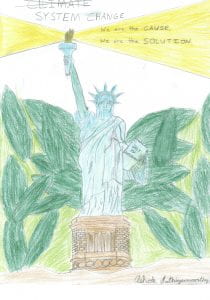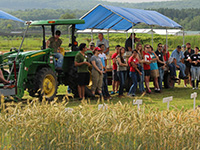Home | Unit 1 | Unit 2 | Unit 3 | Unit 4
Learning Activities
- I Can Do It: My Sense of Place
- Act Towards Climate Change with “Ten Simple Things” and More!
- The Big Picture: Action Project-Making a Plan for Climate Resiliency
- Leading by Example-Planning and Leading an Educational Event
- NYS 4-H Virtual Meeting Guidance
Unit Four Facilitator Guide: a downloadable pdf of Unit Four, complete with activities, handouts and tools for facilitators.
Introduction
In Unit THREE: Community Action your group participated in a series of experiential activities leading up to the final preparation and presentation of a group video project. First, they explored videos showcasing communities taking action to address climate change issues, planning for resiliency and implementing ways to reduce their carbon footprint. These videos were also used as a tool to provide technical examples of how to your group would produce their own videos featuring local citizens taking action against climate change. During the video production process, your group reflected on their personal stewardship, teamed up to practice interview skills, and sought out others in their local community to interview, who are inspirational and promoting positive change.
Unit FOUR: Let’s Do It! provides activities for youth of all skill levels, to explore opportunities that help them to plan and prepare to take action for their future by taking a more informed, less alarming approach. Using what they have learned in this program, this unit offers tools and strategies for youth to become leaders who go forth and teach others in their own communities. With a greater awareness of their sense of place and understanding of community resiliency, methods of sustainability and a systems approach, youth will be more self-confident making positive change. In doing so, they have matured into young leaders who will share this knowledge to help others to forge pathways to a better future.
Target Objectives
- Define and distinguish differences between short, medium and long-term outcomes.
- Demonstrate a sense of place within a system and personal impacts that promote positive outcomes.
- Implement a plan that increases environmental sustainability and promotes a greener world.
- Formulate a plan for Climate Resiliency.
- Determine cause and effects of one’s actions and justify a commitment towards positive changes.
- Promote climate change action by taking the lead and educating others on building a more sustainable future.
Thriving Model Attributes
- Youth Engagement: growth mindset, hopeful purpose, transcendental awareness, goal management
- Developmental Outcomes: social competence, contribution to others, connection to others, personal responsibility
- Long-Term Outcomes: civic engagement, vocational success, happiness and wellbeing
Keep the discussion going about Climate Change
As climate change discussion and beliefs may differ, it is advisable for educators and youth leaders to be ready to respond to those feeling climate anxiety or those in need of factual knowledge. To provide the public with awareness of climate change risks, we need to frame conversations around climate change impacts and the capacity of our community to adapt and be engaged. We need not have all the answers to play a critical role in addressing climate change, as this is an ever-changing, complex topic that still has unknown factors.
Facilitate conversations and dialogue that allow youth to fully engage and express personal viewpoints, and to process any emotional response such as worry, fear, interest, and curiosity which may emerge in their understanding about climate change and their vision of the future. We can promote a positive tone while using scientific evidence, when participating in discussions around the critical nature of the issue and offer strategies for curbing and adapting to climate impacts.
Authors: Donna Alese Cooke, Christine Hadekel, Augustine Bonane, 4-H Youth CAN Teen Leader Intern; Reviewers: Marcia Eames-Sheavly, Ashley M. Helmholdt










